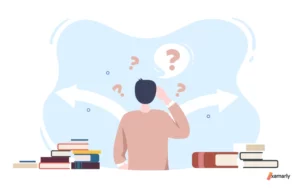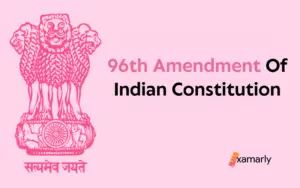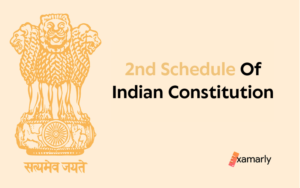The National Commission for Backward Classes was given constitutional status by the Constitution of India’s 102nd Amendment, also known as the Constitution (One Hundred and Second Amendments) Act of 2018.
In May 2021, the Court verdict said that the 102nd Amendment Act of 2018 eliminated states’ authority in the matter to establish socially and educationally backward classes within their borders for the purpose of granting quotas in jobs and admissions in educational institutions.
This article will help you to gain more information on the 102 Amendment of the Indian Constitution.
This is an important segment for the UPSC’s polity and governance portion of the UPSC General Studies Syllabus.
- 102 Amendment of the Indian Constitution
- History and Buildup to the 102nd Amendment of the Indian Constitution
- Effects of the 102 Constitutional Amendment Act
- Amendments Have Been Made to Article 366 of the Indian Constitution
- There Has Been a Change to Article 338B of the Indian Constitution
- The Indian Constitution was Updated by Adding Article 342A.
- Conclusion
- FAQs
- Q1. How Many Amendments Does India Have?
- Q2. Name The First Amendment Made In Indian Constitution.
- Q3. Who Introduced The Bill For The 102 Constitutional Amendment Act In The Lok Sabha?
- 4. What are the goals of India's 102 constitutional amendments, and how did they come about?
- Q5. Who Has The Power To Change The List Of Socially And Educationally Backward Classes (SEBC) Under The 102 Constitutional Amendment Act?
- Q6. Who Can Proclaim A Community A Socially And Educationally Backward Class (SEBC) Under The 102 Constitutional Amendment Act?
- 102 Amendment of the Indian Constitution
- History and Buildup to the 102nd Amendment of the Indian Constitution
- Effects of the 102 Constitutional Amendment Act
- Amendments Have Been Made to Article 366 of the Indian Constitution
- There Has Been a Change to Article 338B of the Indian Constitution
- The Indian Constitution was Updated by Adding Article 342A.
- Conclusion
- FAQs
- Q1. How Many Amendments Does India Have?
- Q2. Name The First Amendment Made In Indian Constitution.
- Q3. Who Introduced The Bill For The 102 Constitutional Amendment Act In The Lok Sabha?
- 4. What are the goals of India's 102 constitutional amendments, and how did they come about?
- Q5. Who Has The Power To Change The List Of Socially And Educationally Backward Classes (SEBC) Under The 102 Constitutional Amendment Act?
- Q6. Who Can Proclaim A Community A Socially And Educationally Backward Class (SEBC) Under The 102 Constitutional Amendment Act?
102 Amendment of the Indian Constitution
To begin with, it was supposed to provide the National Commission for Backward Classes with official standing under the law.
Article 342A granted powers to the President to declare a caste as an SEBC, and the President may make an amendment to the list with a law passed by the Parliament.
But states cannot declare a new caste. All they can do is recommend it. This means that the state government cannot declare a new caste as a BC (Backward Class).
The 102 amendment of the Indian constitution (i.e. 102 caa) seeks to give the National Commission for Backward Classes a constitutional status, making it a quasi-independent body that examines welfare measures and complaints for socially and educationally backward classes.
The commission was to be equal to the National Commission for Scheduled Castes and the National Commission for Scheduled Tribes.
History and Buildup to the 102nd Amendment of the Indian Constitution
In the 1950s and 1970s, two Backward Class Commissions were appointed. After the second one was appointed by the Supreme Court, the court, in 1992, directed a permanent body to examine and entertain complaints of socially and educationally backward classes.
The National Commission for Backward Classes Act was passed in 1993. As part of the Ministry of Social Justice and Empowerment, the NCBC was a statutory body.
Time passed and in 2017, the 123rd Constitution Amendment bill was introduced to safeguard the interests and benefits of Backward Classes efficiently.
A separate bill repealed the Backward Classes Act, of 1993. A constitutional amendment to the Indian Constitution in 2018 gave the National Commission of Backward Classes constitutional status.
Effects of the 102 Constitutional Amendment Act
The followings are the primary three effects or consequential amendments of the 102 Constitutional Amendment Act:
Amendments Have Been Made to Article 366 of the Indian Constitution
As an effect of the 102nd Indian Constituent Amendment Act, Article 366 was also amended to include the words “socially and educationally backward classes” to define the backward classes deemed by the Central Government and States and Union Territories of India.
There Has Been a Change to Article 338B of the Indian Constitution
The organisation of the NCBC as well as its tasks are described in further depth under Article 338B of the 102nd Amendment to the Indian Constitution.
According to the information presented in the article, the chairman, vice-chairperson, and three other members of the committee are all appointed by the president.
The National Commission for Backward Classes (NCBC) is responsible for overseeing issues related to the safeguards afforded to the socially and educationally Backward Classes (SEBCs), investigating complaints of violations of their rights, and proposing measures to incorporate safeguards and welfare measures.
NCBC also presents an annual report to the President. As part of its investigation into allegations that members of socially and educationally disadvantaged groups had their rights violated, the Commission was granted the jurisdiction to perform the functions of a civil court according to an article in the constitution.
The Indian Constitution was Updated by Adding Article 342A.
Article 342A has a significant role to play in the 102 Amendment of the Indian Constitution.
This article empowers the President to specify the Central list of OBCs or “socially and educationally backward classes” for employment under the Union government.
However, the President needs to seek the concurrence of the State’s governor where the Backward List is located before changing the list.
In addition, it mandates the consent of the legislative body prior to the insertion or removal of any municipality from the list of backward classes, regardless of the circumstances.
Conclusion
Many deemed some parts of the 102 Amendment of the Indian Constitution as unconstitutional. Then the Parliament made amendments to this act to live up to the values enshrined in the preamble of India.
An explanation clause was also added to clarify that all the States and Union Territories of India will have the right to prepare and maintain their lists of Socially and Educationally Backward Classes apart from the Central List.
As a matter of fact, we can see that the reason behind Article 102 of the Indian Constitution is to facilitate everyone with equal opportunities irrespective of other societal factors.
The concept of majority and minority will hold value in them as the aforementioned Article demands this segregation to be exercised.
FAQs
Q1. How Many Amendments Does India Have?
As of February 2021, there are 104 amendment acts in the Indian Constitution that have been implemented over time.
Q2. Name The First Amendment Made In Indian Constitution.
101 amendment of the Indian Constitution is the first amendment made in the constitution of India.
Q3. Who Introduced The Bill For The 102 Constitutional Amendment Act In The Lok Sabha?
Thawar Chand Gehlot, Minister of Social Justice and Empowerment in the Lok Sabha, introduced the bill for the 102 Constitutional Amendment Act.
4. What are the goals of India’s 102 constitutional amendments, and how did they come about?
As part of the 102nd Amendment’s original plan, the National Commission for Backward Classes (NCBC) was to join the National Commission for Scheduled Castes (NCSC) and the National Commission for Scheduled Tribes (NCST) in receiving constitutional recognition. However, this did not happen. On the other hand, this was not the case.
Q5. Who Has The Power To Change The List Of Socially And Educationally Backward Classes (SEBC) Under The 102 Constitutional Amendment Act?
The Parliament has the power to change the list of SEBCs under the 102 Constitutional Amendment Act.
Q6. Who Can Proclaim A Community A Socially And Educationally Backward Class (SEBC) Under The 102 Constitutional Amendment Act?
A group may be designated as a Socially and Educationally Backward Class under the 102 Constitutional Amendment Act by the President of India.
The National Commission for Backward Classes was given constitutional status by the Constitution of India’s 102nd Amendment, also known as the Constitution (One Hundred and Second Amendments) Act of 2018.
In May 2021, the Court verdict said that the 102nd Amendment Act of 2018 eliminated states’ authority in the matter to establish socially and educationally backward classes within their borders for the purpose of granting quotas in jobs and admissions in educational institutions.
This article will help you to gain more information on the 102 Amendment of the Indian Constitution.
This is an important segment for the UPSC’s polity and governance portion of the UPSC General Studies Syllabus.
102 Amendment of the Indian Constitution
To begin with, it was supposed to provide the National Commission for Backward Classes with official standing under the law.
Article 342A granted powers to the President to declare a caste as an SEBC, and the President may make an amendment to the list with a law passed by the Parliament.
But states cannot declare a new caste. All they can do is recommend it. This means that the state government cannot declare a new caste as a BC (Backward Class).
The 102 amendment of the Indian constitution (i.e. 102 caa) seeks to give the National Commission for Backward Classes a constitutional status, making it a quasi-independent body that examines welfare measures and complaints for socially and educationally backward classes.
The commission was to be equal to the National Commission for Scheduled Castes and the National Commission for Scheduled Tribes.
History and Buildup to the 102nd Amendment of the Indian Constitution
In the 1950s and 1970s, two Backward Class Commissions were appointed. After the second one was appointed by the Supreme Court, the court, in 1992, directed a permanent body to examine and entertain complaints of socially and educationally backward classes.
The National Commission for Backward Classes Act was passed in 1993. As part of the Ministry of Social Justice and Empowerment, the NCBC was a statutory body.
Time passed and in 2017, the 123rd Constitution Amendment bill was introduced to safeguard the interests and benefits of Backward Classes efficiently.
A separate bill repealed the Backward Classes Act, of 1993. A constitutional amendment to the Indian Constitution in 2018 gave the National Commission of Backward Classes constitutional status.
Effects of the 102 Constitutional Amendment Act
The followings are the primary three effects or consequential amendments of the 102 Constitutional Amendment Act:
Amendments Have Been Made to Article 366 of the Indian Constitution
As an effect of the 102nd Indian Constituent Amendment Act, Article 366 was also amended to include the words “socially and educationally backward classes” to define the backward classes deemed by the Central Government and States and Union Territories of India.
There Has Been a Change to Article 338B of the Indian Constitution
The organisation of the NCBC as well as its tasks are described in further depth under Article 338B of the 102nd Amendment to the Indian Constitution.
According to the information presented in the article, the chairman, vice-chairperson, and three other members of the committee are all appointed by the president.
The National Commission for Backward Classes (NCBC) is responsible for overseeing issues related to the safeguards afforded to the socially and educationally Backward Classes (SEBCs), investigating complaints of violations of their rights, and proposing measures to incorporate safeguards and welfare measures.
NCBC also presents an annual report to the President. As part of its investigation into allegations that members of socially and educationally disadvantaged groups had their rights violated, the Commission was granted the jurisdiction to perform the functions of a civil court according to an article in the constitution.
The Indian Constitution was Updated by Adding Article 342A.
This article empowers the President to specify the Central list of OBCs or “socially and educationally backward classes” for employment under the Union government.
However, the President needs to seek the concurrence of the State’s governor where the Backward List is located before changing the list.
In addition, it mandates the consent of the legislative body prior to the insertion or removal of any municipality from the list of backward classes, regardless of the circumstances.
Conclusion
Many deemed some parts of the 102 Amendment of the Indian Constitution as unconstitutional. Then the Parliament made amendments to this act to live up to the values enshrined in the preamble of India.
An explanation clause was also added to clarify that all the States and Union Territories of India will have the right to prepare and maintain their lists of Socially and Educationally Backward Classes apart from the Central List.
As a matter of fact, we can see that the reason behind Article 102 of the Indian Constitution is to facilitate everyone with equal opportunities irrespective of other societal factors.
The concept of majority and minority will hold value in them as the aforementioned Article demands this segregation to be exercised.
FAQs
Q1. How Many Amendments Does India Have?
As of February 2021, there are 104 amendment acts in the Indian Constitution that have been implemented over time.
Q2. Name The First Amendment Made In Indian Constitution.
101 amendment of the Indian Constitution is the first amendment made in the constitution of India.
Q3. Who Introduced The Bill For The 102 Constitutional Amendment Act In The Lok Sabha?
Thawar Chand Gehlot, Minister of Social Justice and Empowerment in the Lok Sabha, introduced the bill for the 102 Constitutional Amendment Act.
4. What are the goals of India’s 102 constitutional amendments, and how did they come about?
As part of the 102nd Amendment’s original plan, the National Commission for Backward Classes (NCBC) was to join the National Commission for Scheduled Castes (NCSC) and the National Commission for Scheduled Tribes (NCST) in receiving constitutional recognition. However, this did not happen. On the other hand, this was not the case.
Q5. Who Has The Power To Change The List Of Socially And Educationally Backward Classes (SEBC) Under The 102 Constitutional Amendment Act?
The Parliament has the power to change the list of SEBCs under the 102 Constitutional Amendment Act.
Q6. Who Can Proclaim A Community A Socially And Educationally Backward Class (SEBC) Under The 102 Constitutional Amendment Act?
A group may be designated as a Socially and Educationally Backward Class under the 102 Constitutional Amendment Act by the President of India.






